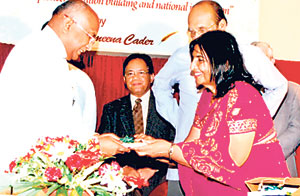What a small world! This expression takes on a special meaning when one reads Noorul Ameena Cader’s biography of her father Mohamed Abdullah Akbar, a community leader whose glittering life was as shiny as the gems he traded around the world. This is because the reader recognizes at least some of the people mentioned in the book – the Akbars of Matara, a town that has produced many an entrepreneur from both the Sinhala and Muslim communities.
 |
| Ameena presenting the first copy of her book to Cultural Minister Mahinda Yapa Abeywardena |
Although it is easy for a daughter to relate the story of her father – especially when she has spent her childhood and adult life under his care and guidance, listening to his adventures and admiring his feats – it is certainly no easy task when it comes to writing his biography. It requires research and collection of material from different sources, for incidents and facts have to be checked and double-checked.
Well, Ameena has done it with due diligence. Thus the book is rich in anecdotes that make it interesting reading. These anecdotes, together with her simple but elegant style of writing, make reader fatigue disappear and allow one to enjoy the pleasure of reading. These anecdotes include Mr. Akbar’s meeting with Princess Olga, daughter of Czar Nicholas II; the story of the willow tree romance which dates back to the Ming dynasty and Maha Kavi Kalidas’ connection with the Akbars’ abode in Matara. These anecdotes have been judiciously scattered throughout the book, tempting the reader to read on.
According to the book, the ancestors of the Akbars of Matara came from Arabia and perhaps were linked to Abu Bakr, the first Caliph of Islam after the demise of Prophet Muhammad. However, Ameena says Akbars can trace their ancestry back, with certainty, to Sheikh Muhammad Ali Hussain of Saudi Arabia. Though the book is largely about Mohamed Abdullah Akbar and the Akbars, it is certainly a case study of Sri Lanka Muslims.
Many a book has been written about Sri Lanka’s Muslims but books like Ameena’s help, like light from a torch, to delve deeper into the uncharted interior of a community.
Ameena’s book is a glimpse into the life and times of wealthy Muslims in the late 19th century and early 20th century. The Muslim culture, the traditions, the dress, religious practices, family values and other valuable information of that era have been skilfully woven into the story of her father and preserved for generations to come.
The book is also a case study of the Sinhala-Muslim amity that existed during colonial times and after. Even at the launch of the book on Wednesday August 12 at the Millennium City Club House at Athurugiriya, speaker after speaker spoke at length about the Sinhala-Muslim relations in the south. The speakers included Ministers Mahinda Yapa Abeywardene and D.E.W. Goonesekara and Ameena’s brother and attorney Zem Zem Akbar.
Thus the book is not only of value to the Akbars but also to students of sociology. It is also a page of Sri Lanka’s history if history is what Cicero defines as “the witness that testifies to the passing of time; it illuminates reality, vitalizes memory, provides guidance in daily life, and brings us tidings of antiquity.”
On a personal level, the reading of the book evoked memories of my father. I am sure that readers of this book will fondly remember their own fathers and discover the spring of love in their hearts for them.
Ameena shows her gratitude to her father, the great patriarch of the Akbars, by not resorting to any catchy title for the book, but by giving it the name of her father himself. She could not have given a better name to the book than this, given the stature of the widely-travelled and much enlightened great man. She could have written volumes on “me and my father”, but she has limited her book to some 100-odd pages. |

